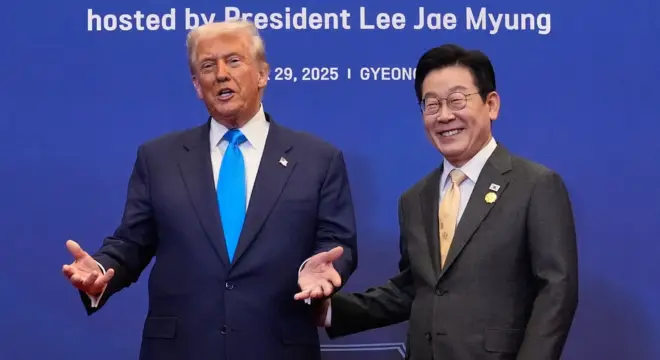Okay, imagine this — one announcement, and the whole world starts talking.
Yep, that’s exactly what happened when Trump approves South Korean nuclear submarine construction 2025, a bombshell update that instantly grabbed global attention.
Former U.S. President Donald Trump officially gave South Korea the green light to build its very own nuclear-powered submarine.
Sounds huge, right?
- But wait — what does this really mean?
- Why is everyone from Washington to Seoul buzzing about it?
- And could this change the entire balance of power in Asia?
Let’s break it all down — from how it started, to why it’s shaking up global politics.
The Big Reveal — Trump’s Surprising Statement
So here’s how it went down.
On October 30, 2025, Trump took to his platform, Truth Social, and announced:
“I have authorized South Korea to build nuclear-powered submarines instead of the outdated diesel ones they currently possess. The South Korea–U.S. military alliance is stronger than ever.”
Boom — just like that, history was made.
This isn’t just another defense update — it’s a major shift in global security. Because let’s be honest, the U.S. doesn’t just hand out nuclear submarine tech like candy. In fact, only the U.K. has ever received such permission from the U.S., way back in the 1950s.
So, why now? Why South Korea?
How It All Started — The Summit That Changed Everything
Let’s rewind a bit.
A day before the announcement, Trump was in South Korea, attending a bilateral summit with President Lee Jae Myung.
The two leaders discussed trade, defense, and — of course — the growing tension in the region, especially with North Korea and China ramping up military moves.
During that meeting, President Lee reportedly asked Trump to allow South Korea to receive fuel for nuclear-powered submarines — something the U.S. had always been hesitant to approve.
And then came the twist.
Within 24 hours, Trump publicly confirmed it — saying yes to South Korea’s long-held dream of joining the “nuclear sub club.”
The Deal Behind the Decision
Now, this wasn’t just about submarines. There was a bigger deal at play.
As part of their new trade agreement, South Korea agreed to invest $350 billion in the U.S. economy, with an additional $150 billion going directly into reviving American shipbuilding.
And guess what?
Trump announced that the submarine will be built at the Hanwha Philly Shipyard — a U.S.-based facility recently bought by South Korea’s Hanwha Group.
So in a way, it’s a win-win —
🇺🇸 U.S. gets billions in investment and job creation,
🇰🇷 South Korea gets its long-awaited green light for nuclear-powered defense.

But… What About Technology?
Now here’s where things get tricky.
Building a nuclear submarine isn’t like upgrading a smartphone. It’s extremely complex — and nuclear propulsion technology is one of the most guarded secrets in the world.
Experts are already asking:
- Will the U.S. really share its nuclear propulsion tech?
- Or will South Korea only get limited access?
- And what about the safeguards to prevent nuclear proliferation?
According to arms control experts like Daryl Kimball from the Arms Control Association, this decision raises big questions about global safety and the Non-Proliferation Treaty (NPT).
Because here’s the thing — these submarines run on highly enriched uranium, which can also be used to make nuclear weapons. So yeah, it’s sensitive stuff.
Why South Korea Wants It So Badly
But you might be wondering — why is South Korea so desperate for nuclear submarines in the first place?
Simple: security.
With North Korea already showing off its own nuclear-powered submarine plans and China expanding its presence in nearby seas, South Korea feels it needs to step up its game.
President Lee even told Trump that these submarines would reduce the defense burden on U.S. troops stationed in the region.
In short — Seoul wants more independence in its defense while still maintaining a strong alliance with Washington.
The Global Reactions — Mixed But Loud
After Trump’s announcement, reactions poured in fast.
Supporters called it a bold move that strengthens the South Korea–U.S. alliance and ensures peace through power.
Critics, however, weren’t so sure. They warned it could fuel an arms race in Asia, especially with North Korea and China watching closely.
Even the International Atomic Energy Agency (IAEA) might need to step in to monitor how nuclear materials are used under this new deal.
Meanwhile, the Chinese government stayed quiet — at least officially — but analysts say Beijing is not thrilled about this development.
Trade, Politics, and Strategy — The Bigger Picture
Let’s be real — this move isn’t just about submarines.
It’s about leverage.
Trump, known for his deal-making style, turned this into a “security for investment” transaction.
He secured hundreds of billions in U.S. investments while giving South Korea a major strategic boost.
Experts are already calling this summit a mix of “commercialized alliance and politicized peace.”
In simpler terms — both leaders got what they wanted, but the U.S. might have gotten the bigger slice of the pie.
So What Happens Next?
Here’s the million-dollar question:
When will South Korea actually start building these nuclear-powered submarines?
As of now, the details are still unclear —
No confirmed timeline.
No clear info on whether nuclear propulsion tech will be transferred.
And no official word from the Pentagon yet.
But one thing’s for sure — this marks a historic turning point in how the U.S. and South Korea cooperate on defense.
Conclusion
Whether you see it as a smart strategic partnership or a risky political gamble, one thing’s undeniable —
Trump’s decision to approve South Korea’s nuclear submarine construction has rewritten the rules of regional security.
For South Korea, it’s a leap toward self-reliance.
For the U.S., it’s a power play with massive economic and political gains.
And for the rest of the world?
It’s a story everyone’s watching closely.
Because when nuclear submarines, politics, and global power collide — history is bound to change.


